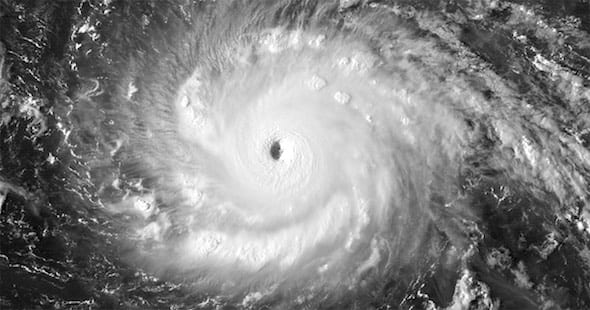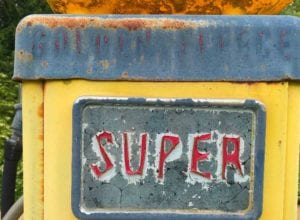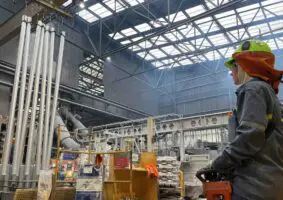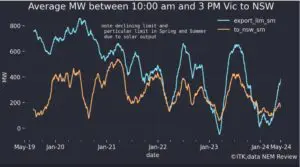The National Hurricane Center issued its final advisory for Irma on Monday night, September 11, but for millions of people left in the storm’s wake, the disaster remains far from over. One stark reminder? Power outages. Everywhere.
Across the Caribbean, through the entirety of Florida, up into Georgia, and spreading into the Carolinas, Irma ripped power from the people.
Seventeen million people, at its peak.
Which means 17 million people without air conditioners in the sweltering heat and humidity, 17 million people without refrigerators keeping food and medicine safe, 17 million people without lights at home or along the roads, 17 million people without internet to stay informed, 17 million people suffering business interruptions and loss, and 17 million people without the assurance of critical infrastructure dependent on power—first responders, hospitals, drinking water, sewage—being able to keep their operations going. We’ve already seen the tragedy that can occur when these systems fail, with the loss of eight lives at a nursing home unable to cope, powerless in the oppressive Florida heat.
Following herculean round-the-clock efforts of the largest assembly of restoration workers in history, the lights are starting to flicker back on across the Southeast. But questions about these outages—how many, why, for how long, and critically, could it have gone better—abound. Here, a quick run-down of what we know, what we don’t, and what we’ll be looking to see in the days, weeks, and months to come.
How big was this power outage and how long will it last?
Current estimates place the number of people impacted by outages from Irma at more than 16 million across the southeastern US. When you add in outages across the Caribbean, where homes and infrastructure have seen even more severe damage, the count climbs higher to 17 million. It will take some time to get final official numbers, but the rough-cut already confirms a mind-bogglingly high number of people got left in the dark.
Just how high? When we compare customer outage counts (which is different from people; utilities tally each account as one “customer,” but accounts can represent multiple people living in the home or working in the business located behind the meter) from some major recent storms, Irma’s preliminary 8.956 million across five states, Puerto Rico, and the US Virgin Islands looks like it will probably top the list:
- Sandy (2012): 8.66 million customers
- Irene (2011): 6.69 million customers
- Gustav (2008): 1.1 million customers
- Ike (2008): 3.9 million customers
- Katrina (2005): 2.7 million customers
- Wilma (2005): 3.5 million customers
- Rita (2005): 1.5 million customers
But here’s a critical point. In many ways, the duration of an outage determines the severity of its consequences. Lights out for a night? For most: an inconvenience. Lights out for several days, a week, or even longer? The triggering of a cascade of disastrous and potentially life-threatening consequences. And in a comparison of the 2005 and 2008 hurricane seasons below, we can see clearly that across storms, the initial magnitude of peak outages does not necessarily align with the subsequent duration borne by large numbers of people:
Right now, we know that the peak number of customers experiencing outages from Irma tops those tallied in the storms above, but we don’t yet know how long all of these outages will last. Already utilities have returned millions of people to power across the Southeast—Wednesday evening’s situation report had the total number without power at over 4.2 million; down steeply from its peak, yet still high—and are predicting that many more will be restored by the end of this weekend. Still, the utilities have flagged that they expect some segment of customers will remain without power for yet another week, or a full two weeks after the storm initially blew through.
One thing to watch? Who’s left in the dark the longest. The order in which customers get returned to power can have life-threatening consequences. Tragically, lives have already been lost from these outages. As coordination between utilities and local governments grow, in addition to prioritizing critical infrastructure, it is imperative to identify those populations most in need of attention—including the elderly, those with disabilities, and low-income populations—to help ensure prioritized and equitable attention for those who are least able to cope with the aftermath of severe weather events.
What caused these widespread outages?
Severe storms can present many and varied threats to the electricity system, from high winds, trees, and flying debris taking down power lines, to storm surge and inland flooding laying siege to substations, transformers, buried power lines, and even power plants. And in a centralized grid, where electricity from large power plants gets routed along transmission and distribution lines until it finally reaches a customer at the end of the wire, outages occurring along any part of the system can ripple down the line.
We know from a previous UCS analysis of the southeastern Florida and Charleston and South Carolina Lowcountry electricity grid that critical electrical infrastructure is located in areas highly susceptible to flooding from storm surge. However, in some places Irma ended up sparing significant storm surge, yet still the power went out. Why?
Wind, for one. Heavy winds can snap poles, send trees crashing onto wires, loft dangerous flying debris, and otherwise rip lines from homes and businesses. But flooding almost certainly contributed in places as well, especially in locations where storm surge and rainfall was worse. And finally in some places, utilities themselves may have caused the outages by pre-emptively cutting power to parts of the grid to better protect potentially inundated infrastructure.
Depending on the causes of failure, and whether there existed many scattered problems versus several centralized disturbances, the length of repairs—and thus the time until restoration—can vary.
We will be waiting to review the utility’s system assessment following the restoration effort to see, in particular, where the major vulnerabilities in the system were concentrated, which can help us understand what went wrong, what went right, and where more attention must be focused in the future—so stay tuned for updates here.
Utilities in Florida invested billions to storm-harden the grid. Do these outages mean it was a waste?
Following the catastrophic 2004 and 2005 hurricane seasons, Florida took steps to require its utilities to more closely consider storm preparedness. This resulted in several new requests from the state’s Public Service Commission, including a requirement for utilities to adhere to a vegetation management plan (i.e., requiring diligent, intentional tree-trimming schedules), and a requirement that utilities present an annual accounting of storm hardening efforts across their systems.
In response, Florida Power & Light (FPL), the largest utility in the state, has invested on the order of $3 billion since then, with other utilities in the state following suit. In FPL’s case, this has meant replacing thousands of wooden poles with concrete, burying dozens of main power lines, upgrading hundreds of substations with flood-monitoring equipment to pre-emptively shut off power (and thus avoid far worse outcomes than if such equipment were inundated while energized), and installing smart-grid devices throughout the system to help pull back the curtain on where outages are and how to work around them.
So how, then, do we square these $3 billion in investments with the fact that over the course of this storm, a staggering 4.45 million out of 4.9 million FPL customers were affected by outages? Were all the investments, borne on the backs of ratepayers, in vain?
Almost certainly not. For one, where FPL’s investments in grid hardening overlapped with increases in system resilience—or the development of a grid that is flexible, responds to challenges, and enables quick recoveries—these upgrades can help the utility restore power faster. That’s critical for lessening the impact of outages, especially for vulnerable populations, even if it doesn’t lessen the initial scope.
Still, there will be lots to consider after the restoration process is over, and once we have had a chance to see where outages persisted, and why. We will also then be able to study how this restoration evolved compared to previous efforts, and where attention should be focused in the future. At the same time, we already know that utilities have been insufficiently factoring climate change into their current infrastructure plans, leaving today’s investments vulnerable to tomorrow’s conditions. And that, we know, must change.
Is this the future we must accept, or are there things we know we can do better?
In addition to tragic loss of life and property, Hurricane Irma has also forced the reckoning of a new round of questions relating to storm preparedness in a warming world. On the one hand, it is impractical to perfectly protect our electricity infrastructure against all possible power outage threats, and though it’s too soon to tell the degree to which the widespread power outages following Irma could have been avoided, it is possible to accept that such a large storm would have at least resulted in some. (And it’s worth noting that Irma itself could have been far more devastating to parts of the coastal grid had the storm’s path not changed—the performance here should not be evidence of the worst that can happen, as we know a future storm could lay bare other paths of exposure.)
At the same time, we know that prolonged power outages can have catastrophic consequences. In particular, the critical infrastructure upon which we all depend, and the vulnerable populations for whom lasting outages can have the most severe affects, simply cannot be left to chance. We should not, cannot, accept that lives will be lost because the power stayed out.
So where do we go from here?
We put a focus on resilience. Now this is a big conversation, and one demanding attention on many fronts, not just the electricity sector. Because yes, it’s about improving the resilience of the power grid—about which we’ll be writing more in the time to come—but it’s also about advancing complementary measures that get people out of harm’s way to begin with. It’s about climate change, and equity, and infrastructure, and planning—it’s all about the future, and how we best position ourselves to face it.
And that means looking forward, not looking back. So in the time ahead, we’ll be looking to see how the federal government, states, and utilities move forward, and do our best to make sure that when tomorrow’s storm won’t look like today’s, all parties are preparing for the future, not the past.
Julie McNamara is an energy analyst with the Climate & Energy program at the Union of Concerned Scientists, where she analyses state, regional, and national policies relating to clean energy development and deployment.
This article was originally published on the Union of Concerned Scientists blog. Reproduced here with permission












